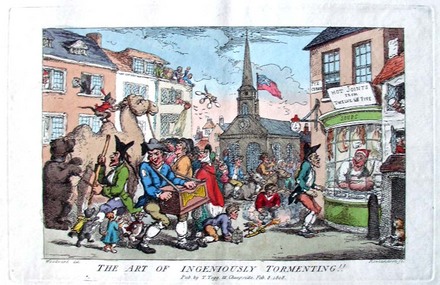Jonathan Swift (1667-1745) wrote the satirical household manual Directions to Servants in 1745 (RHT 18th-581) and eight years later, Jane Collier (1715?-1755) followed with An Essay on the Art of Ingeniously Tormenting (Ex 3684.585.333). Her anti-etiquette handbook provided advice on how to nag and was quickly reprinted six times.
In 1809, an illustrated edition was planned by the popular print publisher Thomas Tegg (1776-1846). The new, corrected, revised, and illustrated Essay featured five plates designed by George Moutard Woodward (1760-1809). A folded frontispiece was etched by Thomas Rowlandson (1756-1827) after Woodward’s drawing (GA Rowlandson 1808.11).
Collier’s narrator advised, “If you have no children, keep as large a quantity of tame animals as you conveniently can. If you have children, a smaller number will do. Shew the most extravagant fondness you possibly can for all these animals. Let them be of the most troublesome and mischievous sort, such as cats, monkeys, parrots, squirrels, and little snarling lapdogs. Their uses for the Tormenting [of] your servants are various.”
Woodward’s frontispiece, as described by Joseph Grego (1843-1908), includes a Savoyard with a barrel-organ and a troop of dancing dogs; a Frenchman with a dancing bear; and a showman dragging a dromedary, with a monkey perched on its back pulling the animal’s ears. Everyone is taunting or torturing someone else.
Graphic Arts has copies of the print in the bound volume, as a separate sheet, and in Caricature Magazine, or Hudibrastic Mirror, another project on which Woodward, Rowlandson, and Tegg were collaborating in 1808. (GA Rowlandson 1807.5f).
See also Joseph Grego (1843-1908), Rowlandson the Caricaturist (London: Chatto and Windus, 1880). Graphic Arts (GARF) Oversize NE642.R7 G8q
